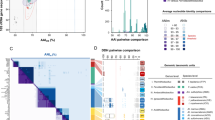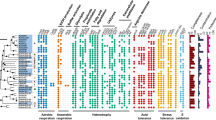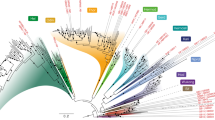Abstract
The first phyla that emerge in the tree of life based on ribosomal RNA (rRNA) sequences are hyperthermophilic, which led to the hypothesis that the universal ancestor, and possibly the original living organism, was hyperthermophilic1. Here we reanalyse the bacterial phylogeny based on rRNA using a more reliable approach, and find that hyperthermophilic bacteria (such as Aquificales and Thermotogales) do not emerge first, suggesting that the Bacteria had a non-hyperthermophilic ancestor. It seems that Planctomycetales, a phylum with numerous peculiarities, could be the first emerging bacterial group.
Similar content being viewed by others
Main
rRNA is a useful tool for investigating the universal phylogeny of life, particularly for uncultured organisms2. The phylogeny of Bacteria based on rRNA is congruent with genomic data, such as phylogenetic trees based on multiple genes3,4. This suggests that rRNA is rarely transferred and indicates that species phylogeny can be deduced by using this marker.
However, rRNA phylogenies can be seriously affected by artefacts of tree construction5. As the most slowly evolving positions are less prone to confounding factors such as multiple substitutions, they probably retain an ancient phylogenetic signal6. Phylogenies constructed by examining these positions are less affected by artefacts. We used the 'slow–fast' method7 to identify these positions, which has proved efficient in analysing eukaryotic phylogeny based on rRNA5.
There are several discrepancies between the standard phylogeny2 and the one we have deduced using the most conserved positions (Fig. 1). Our version shows hyperthermophilic Bacteria (Aquificales and Thermotogales) to be monophyletic, which is consistent with large-scale studies3,4, instead of paraphyletic as in classical versions. More important, our phylogeny shows the late emergence of hyperthermophiles, as they are clustered with Fusobacteria within a vast multifurcation containing almost all the phyla.
The 'slow–fast' method7 was used to estimate the rate of evolution at each position as the sum of the number of substitutions within 19 predefined phyla. Alignments were constructed for various thresholds (0–15) and the most parsimonious was inferred using PAUP 4b8 (alignments and trees are available from the authors). The relative positions of Planctomycetales, Aquificales and Thermotogales remain very similar for all thresholds from 1 to 10. The phylogeny shown here is based on the 751 positions with a threshold of fewer than 5 substitutions, which represents 45% of informative positions and is thus a valid compromise between the quality and the quantity of phylogenetic information.
Surprisingly, Planctomycetales emerge at the base of the Bacteria. Whereas the support for the early branching of hyperthermophilic Bacteria is low (bootstrap value about 20%), slowly evolving positions (Fig. 1) provide reasonable, albeit inconclusive, support for the early emergence of Planctomycetales (bootstrap value about 70%). The basal position of hyperthermophilic phyla is found only when examining noisy (that is, fast-evolving) positions, and is thus probably artefactual. The artefactual attraction of the long branches8 of Archaea and hyperthermophilic Bacteria, and the high guanine and cytosine content of rRNA in most Archaea, Aquificales and Thermotogales9, could explain why hyperthermophiles are often found to branch early in Bacteria.
The emergence of hyperthermophilic Bacteria among mesophiles suggests a secondary adaptation to life at very high temperature for these organisms, which may have been facilitated by massive gene transfer from the Archaea10. The most convincing support for this idea is provided by the enzyme reverse gyrase, which is specific to hyperthermophiles11. This enzyme, which introduces positive supercoils in DNA and is thought to stabilize it at high temperatures, has been independently acquired by Aquifex and Thermotoga from Archaea11. Consistent with the ancestral guanine and cytosine content of rRNA9, our results indicate that the most recent common ancestor of Bacteria was not hyperthermophilic.
We find that Planctomycetales are the first branching bacterial group (Fig. 1). This is a significant, although understudied, division of Bacteria, whose members share several peculiar traits, such as a budding mode of reproduction and the lack of peptidoglycan in their cell walls12. The most intriguing feature of this group is the existence of a single or double membrane around the chromosome in Gemmata sp. and Pirellula sp., respectively, which has been compared to the eukaryotic nucleus12. However, evolutionary homology of these structures with the eukaryotic nucleus has not been proved. An early emergence of Planctomycetales, as inferred from our work, must be confirmed by a careful phylogenetic analysis of genome sequences from several apparently early-branching Bacteria. If our finding is verified, the origin of Bacteria should be seriously reconsidered.
References
Stetter, K. O. Ciba Found. Symp. 202, 1–10 (1996).
Pace, N. R. Science 276, 734–740 (1997).
Brochier, C., Bapteste, E., Moreira, D. & Philippe, H. Trends Genet. 18, 1–5 (2002).
Daubin, V. & Gouy, M. Genome Inform. Ser. Workshop Genome Inform. 12, 155–164 (2001).
Philippe, H., Germot, A. & Moreira, D. Curr. Opin. Genet. Dev. 10, 596–601 (2000).
Felsenstein, J. J. Mol. Evol. 53, 447–555 (2001).
Brinkmann, H. & Philippe, H. Mol. Biol. Evol. 16, 817–825 (1999).
Felsenstein, J. Syst. Zool. 27, 401–410 (1978).
Galtier, N., Tourasse, N. & Gouy, M. Science 283, 220–221 (1999).
Nelson, K. E. et al. Nature 399, 323–329 (1999).
Forterre, P., Bouthier de la Tour, C., Philippe, H. & Duguet, M. Trends Genet. 16, 152–154 (2000).
Fuerst, J. A. Microbiology 141, 1493–1506 (1995).
Author information
Authors and Affiliations
Corresponding author
Rights and permissions
About this article
Cite this article
Brochier, C., Philippe, H. A non-hyperthermophilic ancestor for Bacteria. Nature 417, 244 (2002). https://doi.org/10.1038/417244a
Issue Date:
DOI: https://doi.org/10.1038/417244a
This article is cited by
-
Phylogenetic analysis of mutational robustness based on codon usage supports that the standard genetic code does not prefer extreme environments
Scientific Reports (2021)
-
Undinarchaeota illuminate DPANN phylogeny and the impact of gene transfer on archaeal evolution
Nature Communications (2020)
-
Multidomain ribosomal protein trees and the planctobacterial origin of neomura (eukaryotes, archaebacteria)
Protoplasma (2020)
-
Diversity patterns and isolation of Planctomycetes associated with metalliferous deposits from hydrothermal vent fields along the Valu Fa Ridge (SW Pacific)
Antonie van Leeuwenhoek (2018)
-
The Paradigms They Are a-Changin’: past, present and future of PVC bacteria research
Antonie van Leeuwenhoek (2018)
Comments
By submitting a comment you agree to abide by our Terms and Community Guidelines. If you find something abusive or that does not comply with our terms or guidelines please flag it as inappropriate.




